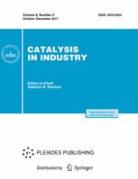BIOFUELS
Hydrocarbon production from bioethanol by newly developed zeolite catalysts is considered. Flexible technology of bioethanol conversion to motor fuel, olefins and aromatics – important products for the petrochemical industry, is developed. Economic and environmental perspectives of petroleum fuels replacement with an alternative fuels is analyzed. Scheme of the mechanism that allows to purposefully control the process of bioethanol conversion is offered. Hydrogenation of the ethanol liquid fraction, containing aromatic hydrocarbons, for the different hydrocarbon fuels production is studied. The sample of reactive synthetic fuel for aircraft gas turbine engines is received.
Organic sources of fuels from renewable biomass are relevant and promising for the harmonious exploitation of raw material sources. Ethanol and other bio alcohols are the most promising sources as basic energy raw materials, like hydrogen and organic components of motor fuels. The paper presents a new results of ethanol, a mixture of ethanol and glycerin (the major product of biomass) conversion to the alkane-olefin fraction C3–C10+ in the presence of nanoscale single-and bimetalcontaining active components deposited on γ-Al2O3 (<d> = 5÷8 Nm), and on the inner surface of the microchannels of ceramic membranes (<d> = 15÷20 nm). The predecessors were a mono-and bimetallic alkoxideand acetate complexes. The selectivity in the conversion of ethanol to aliphatic hydrocarbons, as well as the content of branched structures depends strongly on the nuclearity and composition of the catalytic metal components. For the first time it is found that glycerol exhibits a high reactivity in the cross-condensation reaction of the carbon skeleton of different nature alcohols. A mixture of ethanol and glycerine is converted into a 60 % olefins C4–C10 composition, containing up to 50 % branched structures in the presence of tantalum-rhenium-containing systems. The controlled conversion of ethanol to the olefin, alkane or alkaneolefin fraction is possible by changing the composition of Pd–Zncontaining active ingredients. The developed porous membrane catalyst systems show a high activity in carbon dioxide and steam reforming of ethanol, a mixture of ethanol and glycerol, and acetic acid. The productional scheme for a wide range of valuable organic products based on bio alcohols containing no toxic impurities and independent from crude oil is presented. Under the scheme, alkanes from ethanol and other bio alcohols are major components of motor fuels; a wide range of products of organic synthesis processes carbonylation/hydrocarbonylation can be obtained from olefins, CO and H2.
Cyclic ketals formed as a result of condensation of polyols from renewable sources (glycerol, monosaccharides, etc.) with carbonyl compounds can be used as high-octane and stabilizing additives to ethanol-containing motor fuels. By the example of glycerolacetone condensation with solketal formation, the screening of homogeneous and heterogeneous acid catalysts is carried out including sulphocationite obtained from cross-linked polystyrene with magnetosensitive particles. A high ketal yield (up to 90 %) is reached in catalytic systems capable of proton donation and water fixation. A ketal production scheme is developed, and a pilot facility is built based on the scheme.
The testing of series of Ni-containing catalysts were investigated in the reaction of guaiacol hydrodeoxygenation. Guaiacol is a model compound products of fast biomass pyrolysis. The reaction was carried out in an autoclave at temperature 320 °C and hydrogen pressure 17 MPa. The main products of guaiacol hydrodeoxygenation were cyclohexane, 1- methylcyclohexanediol-1,2 and cyclohexanone (products of aromatic ring reduction). Scheme of transformations of guaiacol, which explains the formation of the main products, is offered. The most active are Ni-containing catalysts on SiO2 and SiO2–ZrO2, prepared by the sol-gel method. According to XRD and EM, high activity of these catalysts is due to high content of active component (nickel) in the dispersed form of restored films on the surface of silicate structures. There is assumption about the prospects of the proposed catalysts in the upgrading of biomass fast pyrolysis products for fuel hydrocarbon production.
Discussed the fundamental problems of search and realization of synergies arising from the mechanochemical pre-processing of vegetable raw materials. Mechanism, relating intense physical and mechanical effects on materials in the process of preliminary preparation of the root hemi-hydrolytic reactions in the mass of structural units of the plant biomass is established. Earlier models have shown that the mechanical effects can influence significantly on the reactivity of macromolecules, alter the hybridization bonds. The biomaterials grinding experiments were conducted to reveal similar patterns in plant structures. The best results were obtained in the extruder in the presence of catalysts of the hydrolytic cleavage of polysaccharides (acids, alkalis, enzymes). It is shown that hydrolytic processes are considerably accelerated in the fields of force extruder using birch wood; operating temperature significantly decreased as compared with thermal hydrolysis; formation of furfural and other harmful by-products were not occur. Experiments have shown that the use of mechanochemical methods can reduce processing time and reduce the formation of by-products, it shows the usefulness of the practical application of this technology.
Ultrasonic influence and the possibility of using its destructive impact on lignocellulose material to increase the reactivity of the plant biomass was studied in the work. The main objective of pretreatment is the destruction of crystalline, highly ordered structure of cellulose and (or remove) lignin. Ultrasonic frequency of 30 kHz used for processing of the raw materials. Destruction of cellulose is about 16 %, lignine – 11,4 % at selected optimum parameters of ultrasonic pretreatment. Ultrasound pretreatment of the substrate alters the speed and depth of the biomass feed decomposition in the process of cultivation, and can be used to accelerate the bioconversion of lignocellulose substrates in the production of biodiesel.
Objectives are to create biocatalysts using recombinant strains of P. verruculosum with increased heterologous expression of endo-β-1, 4-xylanase P. canescens, to analyze the properties of new enzyme preparations, to explore of saccharifying ability of these drugs in the hydrolysis of various types of plant material, shredded aspen and deresined pine wood that is waste of timber and woodworking industry. Enzyme drugs of the present day have not xylanase activity high enough for hydrolysis of xylan rich biomass.Therefore, to obtain the recombinant strains based on the strain of P. verruculosum , containing homologous or heterologous genes of xylanase and mannanase with high activity of xylan conversion is relevant and practical. As a result, enzymes-biocatalysts has been obtained by genetic engineering methods for the hydrolysis of real herbal waste of sawmilling and wood industry. According to the chromatographic separation the obtained products have the following composition: 45–60 % cellulase, 20–50 % xylanase, this composition is optimal for the saccharification of bagasse, aspen and pine wood. The unique of the products is to obtain the biocatalysts with predetermined properties, which significantly reduces the cost of the enzyme, excluding the stage of mixing the individual components carbohydraze complex for hydrolysis of specific plant material – aspen and pine.
The characteristics of production processes of bioethanol and biobutanol, being perspective types of alternative fuels, organized by the use of biocatalysts based on cells of various microorganisms immobilized into polyvinyl alcohol cryogel, are discussed. Biocatalysts on the base of immobilized cells stably provide the ethanol production from different wastes of industry and agriculture (wheat straw, beet and sugar cane bagasse, parchment, corn cob, waste processing of soybean) with high conversion degree of consumed substrates to target product. Ethanol concentrations accumulated in the media with the biocatalysts are much higher as compared to the same characteristics established for the free cells of investigated microorganisms. It was revealed, that immobilized cells of filamentous fungi are capable of conversion of a wider spectrum of sugars present in the treated media to ethanol than traditionally used yeast cells. Immobilization of genus Clostridium cells producing butanol was shown to stably change the relation between solvents accumulated in the medium during «acetone–butanol–ethanol»-fermentation towards increase in butanol part and make characteristics of the process better as compared to known technologies based on application of free bacterial cells.
Screening of microorganisms capable of degradation of cellulose waste to hydrogen was held, also a basis technology for the extraction and use of hydrogen was created. Classical microbiological methods were used to screen. Technology is non-porous polymer membranes were used to extract hydrogen from the culture fluid. Hydrogen is continuously oxidized to form electricity, using innovative technology of enzyme electrode based on hydrogenase. Several high-yield microbiocenosis were selected in the work, the possibility of intensifying the process of microbial hydrogen formation from 20 mM (H2)·l–1·h–1 to 68 mM (H2)·l–1·h–1 due to application of membrane technology shows as well as the possibility of using enzyme fuel electrode for hydrogen oxidation. Maximum output amounted up to 250 mkVt/sm2. It is shown that it is possible to use both technologies for generating electricity and clean hydrogen.
A new biotechnology for biodiesel production based on filamentous fungi lipid was created. Oleogen Mucorales is used as a producer, forming up to 47–50 % lipid composition close to canola oil. The duration of fermentation process is 4–5 days at 27-28 °С. Biodiesel based on fungal lipid satisfies the requirements of European quality EN14214. The possibility is shown to increase the economic effects of biotechnology: 1) to create a waste-free technology by obtaining a single fermentation of biodiesel and chitin, 2) the use a stimulantsof germination of fungus conidia, which could reduce the duration of fermentation, and 3) the use of glycerol formed during the production of methyl esters, as a carbon source in the fermentation medium, as well as a number of food industry wastes and wood hydrolysates in the fermentation process.
This is review about the problems of non-traditional raw materials for biofuels, the results of studies on the synthesis of biodiesel at various lipids, production of lipid materials and the contribution of different sources into a common raw material balance. Questions of the lipase catalysis, the sources and range of commercial preparations of lipase and key issues in biocatalysis technology biodiesel are discussed in details. The use of algal feedstock for the production of fuel ethanol is recommended.
One of the prospective technologies of the production of energy carriers from renewable raw material is biological conversion of organic wastes. The products of this conversion are gaseous (biogas, biohydrogen) or liquid mixtures containing methane and hydrogen or lover alcohols respectively. Traditional membrane systems are considered and original gas-liquid membrane contactors (MCs) are proposed as prospective systems for energy carriers recovery (methane, hydrogen) from gas mixtures. MCs do not demand preliminary compression of initial gas mixture. Technical degree methane (> 95 %) can be obtained after the separation stage of biogas. Low energy consumable membrane system is created on the basis of developments of TIPS RAS in cooperation with experts-microbiologists and specialists in mechanical engineering. Developed MCs are based on non-porous high permeable asymmetric polyvinyltrimethylsilane (PVTMS) membrane which shows the permeance level of CO2 more than 1500 L/(m2·h·atm) that completely satisfy requirements of high permeable and sterile barrier. Composite membranes based on glassy polymer with high free volume – polytrimethylsililpropyne (PTMSP) which are already produced in laboratory scale are considered as prospective membranes for MCs. Application of such membrane methods as pervaporation and membrane recovery of organic component from vapour phase is also perspective for recovery of liquid energy carriers (bioalcohols) from diluted water-organic solutions (range of organic substances concentrations is 1–7 %) obtained by biofermentation. It is shown that organophillic PTMSP membranes can be successfully applied for processes of continuous recovery of liquid energy carriers from products of biomass treatment.
INFORMATION
ISSN 2413-6476 (Online)




























